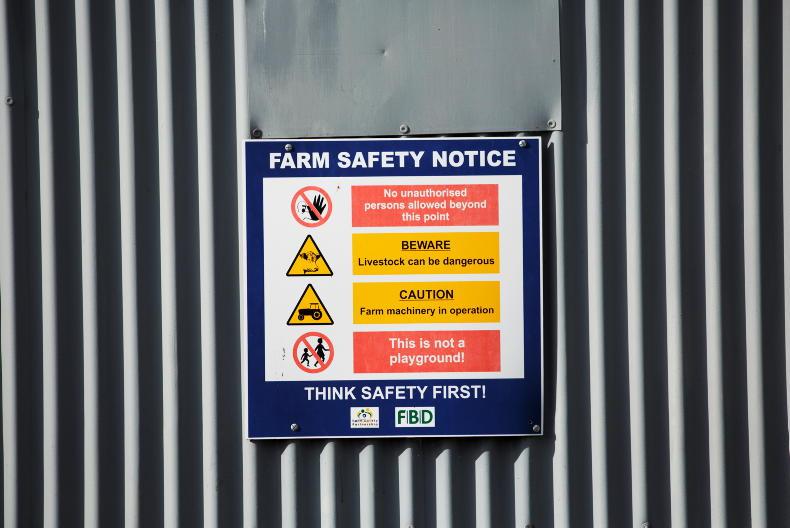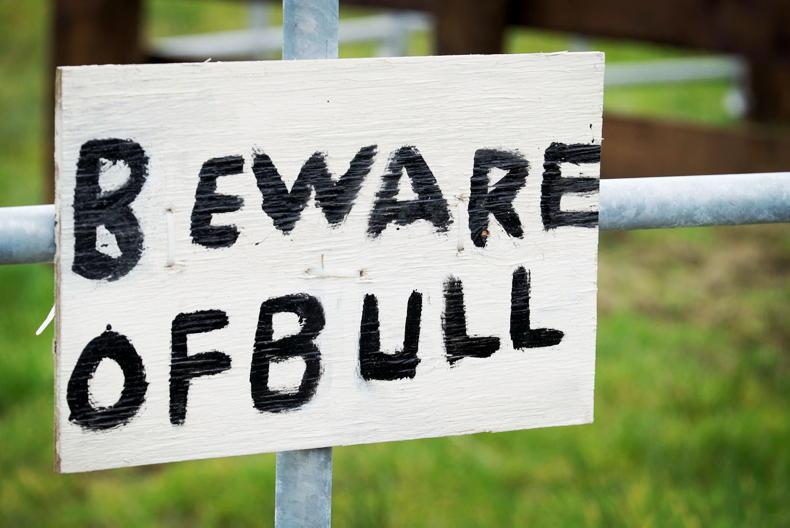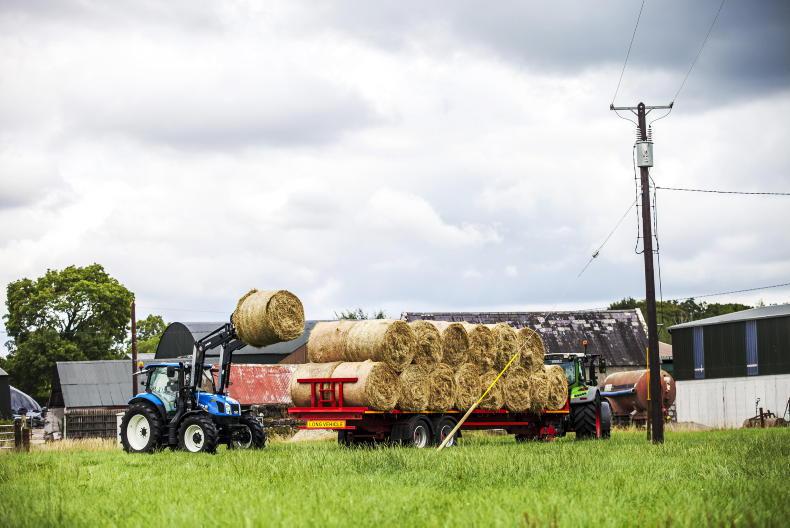Farming is one of the most dangerous work sectors in Ireland. Typically, about 20 workplace deaths occur in the agriculture sector annually.
In 2020, 20 farm deaths occurred, accounting for 37% of all workplace deaths. In 2021, the number of farm deaths reduced to 10 with one in “forestry and logging” and one due to farm construction.
In 2022, five deaths (provisional figure) were reported up to 2 June 2022.
Childhood deaths are particularly tragic and, in recent years, there has been a significant increase in the occurrence of these fatalities.
Farm accidents causing serious injury occur at the high level of 2,800 per year. Drystock farms account for 17% of total accidents.
An accident can lead to a permanent disability and interfere with a person’s ability to farm effectively. Farmers as an occupational group have been identified with having high levels of preventable ill health, which also limits them in farming effectively. More awareness of health promotion practices are needed among the farming community.
Risk assessment
All workplaces, including farms have a legal duty under Safety, Health and Welfare at Work (SHWW) legislation to conduct a risk assessment to ensure that work is carried out safely.
The “green covered” risk assessment document is available to accompany the Farm Safety Code of Practice. It is a legal requirement to complete this updated document annually and when major changes occur to farming systems.
The requirement to conduct a risk assessment replaced the requirement to prepare a safety statement for farms with three or less employees, which are estimated to make up about 95% of farms nationally.
Targeted Agricultural
Modernisation Scheme (TAMS)
Grant aid is available through the various TAMS up to the end of 2022. The main areas where funding is available include: slurry aeration and access manholes, electrical installations and lighting; livestock handling facilities, safety rails and sliding doors.
It is mandatory that all applicants will have completed, within the last five years prior to the submission of their claim for payment, the half-day farm safety code of practice course (given by Teagasc or other trained persons) or the FETAC Level 6 Advanced Certificate in Agriculture (Green Cert).
The claim for payment will not be processed until evidence of completion of the course is provided. It is recommended to discuss a TAMS application before submission with an adviser, to optimise the benefit.
The FBD Insurance booklet “Build in Safety – An Advisory Booklet for Farmers”, outlining how to comply with SHWW construction regulations, is an important reference source.
Accelerated Capital
Allowance Scheme
An Accelerated Capital Allowance programme for farm safety and disability adaptation equipment is in place. To be eligible to claim the accelerated wear-and-tear allowance, the qualifying equipment purchase must occur between 1 January 2021 and 31 December 2023. Currently, capital allowances are available at 12.5% per annum over eight years for agricultural equipment generally.
This scheme allows for accelerated capital allowances of 50% per annum over two years for certain eligible equipment. This eligible equipment includes, for example, chemical storage cabinets, anti-backing gates, big-bag lifters, quick hitch mechanisms for rear and front three-point linkage to enable hitching of implements without need to descend from tractor, as well as adaptive equipment to assist farmers with disabilities.

Agricultural vehicle standards for public roads
Revised standards for use of agricultural vehicles on public roads are in place. In addition to the vehicle, the standards include both trailers and attached machines.
The purpose of the standards is to enhance the safety of road users.
Key requirements of the new legislation include:
Braking: more powerful braking systems will be required for agricultural vehicles operating at speeds in excess of 40km/h. Most of the correctly maintained tractors which have come into use in the past 30 years already meet these requirements. Lighting and visibility: agricultural vehicles will need to be equipped with appropriate lighting systems, flashing amber beacons and reflective markings. Weights, dimensions and coupling: new national weight limits have been introduced. These will enable tractor and trailer combinations which are unplated to continue in use at limits which are safe for such vehicles. Plated tractors and trailer combinations can operate at higher weight limits of up to 24 and 34 tonnes for tandem and triaxle agricultural trailers, respectively, that meet certain additional requirements. 
Sustainable Use of
Pesticides Directive
The purpose of the EU Sustainable Use of Pesticides Directive is to put a legislative system in place to ensure that farm pesticides are used responsibly, safely and effectively, while safeguarding the environment.
Professional pesticide users (PU) must be registered with the Department of Agriculture and have a PU number.
Farmers are classified as professional pesticide users (PUs). In order to register, a farmer must have completed a training course provided by an approved training provider. In the event of a Department inspection, a farmer will be required to produce evidence of having completed appropriate training.

All boom sprayers greater than 3m boom width must be tested. The interval between tests must not exceed five years until 2025. A list of approved sprayer testers is available on the Department’s website.
Safety of children on farms
The safety of children and young persons must be paramount on farms. The following precautions need to be considered when children are present on a farm:
Provide a safe and secure play area for children away from all work activities. Where children are not in a secure play area, a high level of adult supervision is needed.Children should not be allowed to access heights.Action should be taken to keep children away from dangerous areas such as slurry tanks. All open water tanks, wells and slurry tanks should be fenced off.Give children clear instruction on farm safety issues.Children to be carried in the tractor cab (aged seven or older) need to wear a seat belt.The renowned safety booklet for children “Stay Safe with Jesse” is a key reference.
Preventing machinery accidents
Vehicle and machinery-related deaths account for 53% of all farm deaths. For vehicles, being struck (25%) is the most frequent cause of death followed by being crushed or trapped by the vehicle (24%), fall from vehicle (12%) and being pierced by a vehicle part (2%). With machinery, being crushed (23%), struck (18%) or collapse (18%) are the most frequent causes of death followed by power drive entanglement (14%).

The fatal data shows that most accidents occur due to being crushed or struck, so safety vigilance is especially needed when in proximity to moving vehicles/machines.
Entanglement deaths and serious injuries are particularly gruesome and occur most frequently with machines used in a stationary position, such as a vacuum tanker or slurry agitator where contact can occur between the person and the PTO.
Quads (ATVs) are useful machines on farms for travel but they have a high risk of death and serious injury if misused.
Preventing accidents with cattle
On Irish farms, livestock deaths make up 19% of all deaths and 42% of farm accidents.
Cows or heifer accidents account for 33% of livestock-related deaths, with bulls (18%), horses (8%), bullocks and other cattle (41%) accounting for the remainder.
The notable trend is that the percentage of cow/heifer incidents causing death has increased dramatically in the last decade so additional precautions with this livestock group are required.
Farmers are advised to keep a bull’s temperament under constant review, have a ring and chain fitted, keep a bull in view at all times and always have a means of escape or refuge. Breeding cattle for docility should always be considered.
Preventing deaths with slurry
Farm deaths associated with slurry and water account for 10% of farm fatalities, with the majority of these being drowning. Particular care is needed when slurry access points are open and physical guarding needs to be put in place.
Never enter a slurry tank as lack of oxygen or the presence of poisonous gases could be fatal
Slurry gases are a lethal hazard on cattle farms. Hydrogen sulphide is released when slurry is agitated and in calm weather can be present at lethal levels.
The key mitigating controls are to pick a windy day for agitating, evacuate all persons and stock from housing and open all doors and outlets. A range of other gases including methane, ammonia and carbon dioxide are produced from slurry due to fermentation in semi-emptied tanks.
Never enter a slurry tank as lack of oxygen or the presence of poisonous gases could be fatal. Also, never have an ignition source near a slurry tank due to the methane explosion risk.
A major Irish study has indicated that farmers in the “working age” (16 to 65 years) have a 5.1 times higher “all cause” death rate than the occupational group with the lowest rate.
The major causes of elevated death rate include cardiovascular disease (CVD), cancers and injuries.
A further Irish study indicated that 59% of farmers had a health check with their GP in the last year compared to 74% for the general population.
Among farmers, just 27% believed that they were too heavy despite 60% being classified as overweight or obese.
Exercise
Farmers have been shown to achieve an adequate number of steps daily. However, in general, the level of moderate- to high-intensity exercise achieved, which is essential for cardiovascular health, is inadequate.
We can all go through low points from time to time and it is not unusual to experience symptoms related to stress, anxiety and depression. In this regard, a number of national organisations that promote positive mental wellbeing, including Mental Health Ireland and Samaritans Ireland. Embrace Farm, which supports farm families after a farm accident also plays an important role in the mental wellbeing of families.
Farming is one of the most dangerous work sectors in Ireland. Typically, about 20 workplace deaths occur in the agriculture sector annually.
In 2020, 20 farm deaths occurred, accounting for 37% of all workplace deaths. In 2021, the number of farm deaths reduced to 10 with one in “forestry and logging” and one due to farm construction.
In 2022, five deaths (provisional figure) were reported up to 2 June 2022.
Childhood deaths are particularly tragic and, in recent years, there has been a significant increase in the occurrence of these fatalities.
Farm accidents causing serious injury occur at the high level of 2,800 per year. Drystock farms account for 17% of total accidents.
An accident can lead to a permanent disability and interfere with a person’s ability to farm effectively. Farmers as an occupational group have been identified with having high levels of preventable ill health, which also limits them in farming effectively. More awareness of health promotion practices are needed among the farming community.
Risk assessment
All workplaces, including farms have a legal duty under Safety, Health and Welfare at Work (SHWW) legislation to conduct a risk assessment to ensure that work is carried out safely.
The “green covered” risk assessment document is available to accompany the Farm Safety Code of Practice. It is a legal requirement to complete this updated document annually and when major changes occur to farming systems.
The requirement to conduct a risk assessment replaced the requirement to prepare a safety statement for farms with three or less employees, which are estimated to make up about 95% of farms nationally.
Targeted Agricultural
Modernisation Scheme (TAMS)
Grant aid is available through the various TAMS up to the end of 2022. The main areas where funding is available include: slurry aeration and access manholes, electrical installations and lighting; livestock handling facilities, safety rails and sliding doors.
It is mandatory that all applicants will have completed, within the last five years prior to the submission of their claim for payment, the half-day farm safety code of practice course (given by Teagasc or other trained persons) or the FETAC Level 6 Advanced Certificate in Agriculture (Green Cert).
The claim for payment will not be processed until evidence of completion of the course is provided. It is recommended to discuss a TAMS application before submission with an adviser, to optimise the benefit.
The FBD Insurance booklet “Build in Safety – An Advisory Booklet for Farmers”, outlining how to comply with SHWW construction regulations, is an important reference source.
Accelerated Capital
Allowance Scheme
An Accelerated Capital Allowance programme for farm safety and disability adaptation equipment is in place. To be eligible to claim the accelerated wear-and-tear allowance, the qualifying equipment purchase must occur between 1 January 2021 and 31 December 2023. Currently, capital allowances are available at 12.5% per annum over eight years for agricultural equipment generally.
This scheme allows for accelerated capital allowances of 50% per annum over two years for certain eligible equipment. This eligible equipment includes, for example, chemical storage cabinets, anti-backing gates, big-bag lifters, quick hitch mechanisms for rear and front three-point linkage to enable hitching of implements without need to descend from tractor, as well as adaptive equipment to assist farmers with disabilities.

Agricultural vehicle standards for public roads
Revised standards for use of agricultural vehicles on public roads are in place. In addition to the vehicle, the standards include both trailers and attached machines.
The purpose of the standards is to enhance the safety of road users.
Key requirements of the new legislation include:
Braking: more powerful braking systems will be required for agricultural vehicles operating at speeds in excess of 40km/h. Most of the correctly maintained tractors which have come into use in the past 30 years already meet these requirements. Lighting and visibility: agricultural vehicles will need to be equipped with appropriate lighting systems, flashing amber beacons and reflective markings. Weights, dimensions and coupling: new national weight limits have been introduced. These will enable tractor and trailer combinations which are unplated to continue in use at limits which are safe for such vehicles. Plated tractors and trailer combinations can operate at higher weight limits of up to 24 and 34 tonnes for tandem and triaxle agricultural trailers, respectively, that meet certain additional requirements. 
Sustainable Use of
Pesticides Directive
The purpose of the EU Sustainable Use of Pesticides Directive is to put a legislative system in place to ensure that farm pesticides are used responsibly, safely and effectively, while safeguarding the environment.
Professional pesticide users (PU) must be registered with the Department of Agriculture and have a PU number.
Farmers are classified as professional pesticide users (PUs). In order to register, a farmer must have completed a training course provided by an approved training provider. In the event of a Department inspection, a farmer will be required to produce evidence of having completed appropriate training.

All boom sprayers greater than 3m boom width must be tested. The interval between tests must not exceed five years until 2025. A list of approved sprayer testers is available on the Department’s website.
Safety of children on farms
The safety of children and young persons must be paramount on farms. The following precautions need to be considered when children are present on a farm:
Provide a safe and secure play area for children away from all work activities. Where children are not in a secure play area, a high level of adult supervision is needed.Children should not be allowed to access heights.Action should be taken to keep children away from dangerous areas such as slurry tanks. All open water tanks, wells and slurry tanks should be fenced off.Give children clear instruction on farm safety issues.Children to be carried in the tractor cab (aged seven or older) need to wear a seat belt.The renowned safety booklet for children “Stay Safe with Jesse” is a key reference.
Preventing machinery accidents
Vehicle and machinery-related deaths account for 53% of all farm deaths. For vehicles, being struck (25%) is the most frequent cause of death followed by being crushed or trapped by the vehicle (24%), fall from vehicle (12%) and being pierced by a vehicle part (2%). With machinery, being crushed (23%), struck (18%) or collapse (18%) are the most frequent causes of death followed by power drive entanglement (14%).

The fatal data shows that most accidents occur due to being crushed or struck, so safety vigilance is especially needed when in proximity to moving vehicles/machines.
Entanglement deaths and serious injuries are particularly gruesome and occur most frequently with machines used in a stationary position, such as a vacuum tanker or slurry agitator where contact can occur between the person and the PTO.
Quads (ATVs) are useful machines on farms for travel but they have a high risk of death and serious injury if misused.
Preventing accidents with cattle
On Irish farms, livestock deaths make up 19% of all deaths and 42% of farm accidents.
Cows or heifer accidents account for 33% of livestock-related deaths, with bulls (18%), horses (8%), bullocks and other cattle (41%) accounting for the remainder.
The notable trend is that the percentage of cow/heifer incidents causing death has increased dramatically in the last decade so additional precautions with this livestock group are required.
Farmers are advised to keep a bull’s temperament under constant review, have a ring and chain fitted, keep a bull in view at all times and always have a means of escape or refuge. Breeding cattle for docility should always be considered.
Preventing deaths with slurry
Farm deaths associated with slurry and water account for 10% of farm fatalities, with the majority of these being drowning. Particular care is needed when slurry access points are open and physical guarding needs to be put in place.
Never enter a slurry tank as lack of oxygen or the presence of poisonous gases could be fatal
Slurry gases are a lethal hazard on cattle farms. Hydrogen sulphide is released when slurry is agitated and in calm weather can be present at lethal levels.
The key mitigating controls are to pick a windy day for agitating, evacuate all persons and stock from housing and open all doors and outlets. A range of other gases including methane, ammonia and carbon dioxide are produced from slurry due to fermentation in semi-emptied tanks.
Never enter a slurry tank as lack of oxygen or the presence of poisonous gases could be fatal. Also, never have an ignition source near a slurry tank due to the methane explosion risk.
A major Irish study has indicated that farmers in the “working age” (16 to 65 years) have a 5.1 times higher “all cause” death rate than the occupational group with the lowest rate.
The major causes of elevated death rate include cardiovascular disease (CVD), cancers and injuries.
A further Irish study indicated that 59% of farmers had a health check with their GP in the last year compared to 74% for the general population.
Among farmers, just 27% believed that they were too heavy despite 60% being classified as overweight or obese.
Exercise
Farmers have been shown to achieve an adequate number of steps daily. However, in general, the level of moderate- to high-intensity exercise achieved, which is essential for cardiovascular health, is inadequate.
We can all go through low points from time to time and it is not unusual to experience symptoms related to stress, anxiety and depression. In this regard, a number of national organisations that promote positive mental wellbeing, including Mental Health Ireland and Samaritans Ireland. Embrace Farm, which supports farm families after a farm accident also plays an important role in the mental wellbeing of families.










 This is a subscriber-only article
This is a subscriber-only article











SHARING OPTIONS: